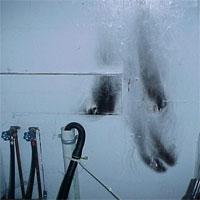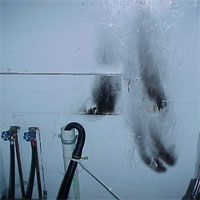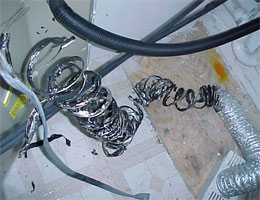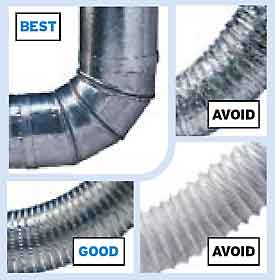You are here
Home ›Clothes Dryer Fires

Homeowners have been lulled to sleep on a serious fire safety issue.
Walk into any hardware store, and you'll find plastic or foil duct extenders for clothes dryer exhaust. Look a little further, and you'll likely find an "energy-saving" heat recovery box.
Odds are that the last time you saw the inside of the clothes dryer exhaust was when you hooked up the dryer.
 Though a full share of dangerous conditions are identified with appliance warnings, many dryer fire incidents remain within the control of the consumer, with proper knowledge and maintenance.
Though a full share of dangerous conditions are identified with appliance warnings, many dryer fire incidents remain within the control of the consumer, with proper knowledge and maintenance.
 Lint accumulation and reduced exhaust airflow feed on each other to provide conditions ripe for a fire. Lint is highly combustible. Interestingly enough, lint is one of the ingredients in a recipe for home-made fire starters. Decreased airflow causes overheating of the exhaust environment, demanding excessive cycling of the high temperature limit switch and eventual failure. If clothes are taking a long time to dry or come out hotter than normal, or if the vent hood flapper doesn't open, maintenance is needed.
Lint accumulation and reduced exhaust airflow feed on each other to provide conditions ripe for a fire. Lint is highly combustible. Interestingly enough, lint is one of the ingredients in a recipe for home-made fire starters. Decreased airflow causes overheating of the exhaust environment, demanding excessive cycling of the high temperature limit switch and eventual failure. If clothes are taking a long time to dry or come out hotter than normal, or if the vent hood flapper doesn't open, maintenance is needed.
Here are actions available to minimize potential for dryer fires, even before the warning signs show up:
 Exhaust duct should be solid metallic material. Vinyl and foil are combustible, and spiral-wound surfaces tend to catch lint more readily. In particular, exhaust duct on gas dryers must be metallic, as the duct also serves as the flue for exhaust gas from the burner, similar to a gas-fired water heater or furnace. In Canada, CSA certification is based on a short length of metallic duct leading to the exterior.
Exhaust duct should be solid metallic material. Vinyl and foil are combustible, and spiral-wound surfaces tend to catch lint more readily. In particular, exhaust duct on gas dryers must be metallic, as the duct also serves as the flue for exhaust gas from the burner, similar to a gas-fired water heater or furnace. In Canada, CSA certification is based on a short length of metallic duct leading to the exterior.- Transition exhaust ducts are allowed if certified to UL 2158A. Hardware stores sell air ducting listed to UL 181 as dryer duct, but it is not certified for that specific use.

This is a label from a UL 181 air connector; it does not signify that the duct is certified as a UL 2158A dryer transition duct. - Exhaust should vent to the exterior, and in no case the attic or crawl space. This is a specific requirement of recent building codes. Inside heat recovery diverter valves or termination boxes do not comply with current standards. Diverting the dryer exhaust to the interior can introduce up to 1½ gallons of water per full load as moisture back into the house.
- Avoid kinking or crushing exhaust to make up for installation in close quarters. This only restricts airflow further. Minimize the length of exhaust duct; it should never exceed 25'.
- Clean the lint trap often. On a regular basis, disconnect, inspect, and clean the exhaust duct run.
The money saved with inexpensive plastic or foil dryer exhaust duct and heat recovery boxes will never offset the loss of life or property.




